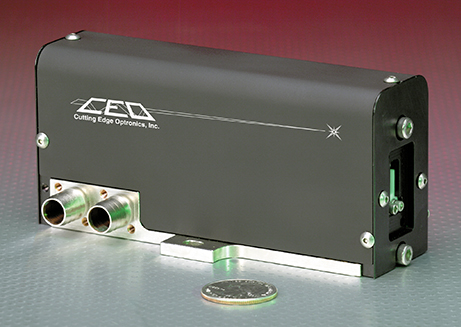Pumped up Lasers
Lasers are a part of our everyday lives and the more uses found for them, the greater the need for them to be more efficient, accurate, and powerful. A Phase II Small Business Innovation Research (SBIR) contract between NASA's Goddard Space Flight Center and Cutting Edge Optronics (CEO) sought to develop such a laser.
The results so far have produced a key component to the ultraviolet (UV) laser Goddard is looking for to conduct atmospheric remote sensing using lidar (Light Detection and Ranging). NASA hopes to use the laser to profile atmospheric wind vectors and potentially to support a spaceborne lidar wind profiling system. Although the laser is still under development, CEO has commercialized a component of the laser system, the diode pump module, which serves as an amplifier.
The commercial version of the diode pump, the Whisper MiniSlab,™ is the "engine" for high performance laser systems. The device magnifies the laser output using a "zig-zag slab," so named for the path the beam takes through the slab-shaped laser crystal. This technique can be advantageous because it eliminates thermal lensing to first order.
One of the innovations of the MiniSlab is the use of conduction cooling as opposed to the more traditional direct water cooling method for cooling the slab. In conduction cooling, two of the slab surfaces are attached to heat sinks while the diode pump arrays pump the other two sides. This technique reduces thermal turbulence typically associated with the direct cooling method.
The absence of thermal turbulence makes the beam pointing very stable. Conduction cooling is also flexible in terms of which cooling scheme is used, with little effect on the laser's performance. Water-cooled heat sinks could be replaced with alternative heat transfer mechanisms such as heat pipes or CEO's phase-change heat sinks. One last benefit is that the coolant does not have to be optically clear and cleanliness is less important since the beam does not pass through the coolant.
Given the numerous applications of lasers, CEO projects a large potential market for their diode-pumped lasers. Diode-pumped lasers are superior to excimer lasers currently popular for medical and industrial applications. Diode-pumped lasers are more reliable, efficient, versatile, stable, rugged, and smaller with a better beam quality than excimer lasers. They are also safer to use, because they do not rely on poisonous gases like gas-discharge laser systems.
The newly designed diode pump has made its first splash in the commercial market. A CEO customer has received two laser units with the new diode pump installed, and applied them to the company's manufacturing process. CEO also has potential clients looking to incorporate the diode pump into lasers used for corneal surgery and commercial lidar activities.
CEO hopes to soon commercialize other parts of the laser system being developed under the SBIR contract, as well as eventually, the entire laser system. With their improved technology, CEO is locked onto its target.
Whisper MiniSlab™ is a trademark of Cutting Edge Optronics.

Cutting Edge Optronics' slab pumphead, the Whisper MiniSlab™ uses innovative cooling methods to produce smaller lasers with better beam quality.













